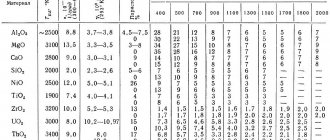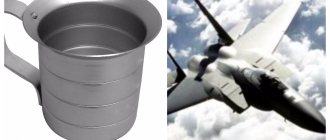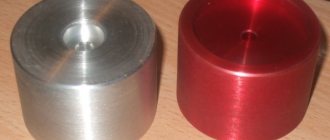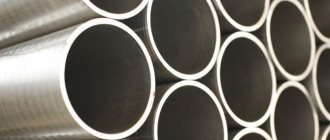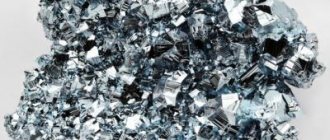Density of materials
Unit
The density of aluminum and any other material is a physical quantity that determines the ratio of the mass of the material to the occupied volume.
- The unit of measurement for density in the SI system is kg/m3.
- For the density of aluminum, a more descriptive dimension g/cm3 is often used.
The density of aluminum in kg/m3 is a thousand times greater than in g/cm3.
Specific gravity
To estimate the amount of material per unit volume, such a non-systemic, but more visual unit of measurement as “specific gravity” is often used. Unlike density, specific gravity is not an absolute unit of measurement. The fact is that it depends on the magnitude of gravitational acceleration g, which varies depending on the location on Earth.
Dependence of density on temperature
The density of the material depends on temperature. It usually decreases with increasing temperature. On the other hand, specific volume—volume per unit mass—increases with increasing temperature. This phenomenon is called thermal expansion. It is usually expressed as a coefficient of thermal expansion, which gives the change in length per degree of temperature, for example mm/mm/ºC. Change in length is easier to measure and apply than change in volume.
Specific volume
The specific volume of a material is the reciprocal of density. It shows the volume of a unit of mass and has the dimension m3/kg. Based on the specific volume of the material, it is convenient to observe the change in the density of materials during heating and cooling.
The figure below shows the change in specific volume of various materials (pure metal, alloy and amorphous material) with increasing temperature. The flat sections of the graphs represent temperature expansion for all types of materials in solid and liquid states. When a pure metal is melted, there is a jump in the increase in specific volume (a decrease in density); when an alloy is melted, it rapidly increases as it melts in the temperature range. Amorphous materials, when melting (at the glass transition temperature), increase their coefficient of thermal expansion [2].
Specific heat capacity of aluminum
The specific heat capacity of aluminum depends significantly on temperature and at room temperature is about 904 J/(kg deg) , which is significantly higher than the specific (mass) heat capacity of other common metals, such as copper and iron.
Below is a comparative table of the specific heat capacities of these metals. The heat capacity values in the table are in the temperature range from -223 to 927°C.
According to the table, it can be seen that the value of the specific heat capacity of aluminum is significantly higher than the value of this property for copper and iron , therefore this property of aluminum, such as the ability to accumulate heat well, is widely used in industry and heating engineering, making this metal irreplaceable.
Aluminum Density
Theoretical density of aluminum
The density of a chemical element is determined by its atomic number and other factors such as atomic radius and the way the atoms are packed. The theoretical density of aluminum at room temperature (20 °C) based on the parameters of its atomic lattice is:
- 2698.72 kg/m3.
Density of aluminum: solid and liquid
A graph of aluminum density versus temperature is shown in the figure below [1]:
- As the temperature increases, the density of aluminum decreases.
- When aluminum transitions from solid to liquid, its density decreases abruptly from 2.55 to 2.34 g/cm3.
The density of aluminum in the liquid state - molten pure aluminum 99.996% - at various temperatures is presented in the table.
Thermal conductivity and density of aluminum
The table shows the thermophysical properties of aluminum Al depending on temperature. The properties of aluminum are given over a wide temperature range - from minus 223 to 1527 ° C (from 50 to 1800 K).
As can be seen from the table, the thermal conductivity of aluminum at room temperature is about 236 W/(m deg) , which makes it possible to use this material for the manufacture of radiators and various heat sinks.
In addition to aluminum, copper also has high thermal conductivity. Which metal has the greater thermal conductivity? It is known that the thermal conductivity of aluminum at medium and high temperatures is still less than that of copper, however, when cooled to 50K, the thermal conductivity of aluminum increases significantly and reaches a value of 1350 W/(m deg). For copper, at such a low temperature, the thermal conductivity value becomes lower than for aluminum and amounts to 1250 W/(m deg).
Aluminum begins to melt at a temperature of 933.61 K (about 660 ° C), while some of its properties undergo significant changes. The values of properties such as thermal diffusivity, aluminum density and thermal conductivity are significantly reduced.
The density of aluminum is mainly determined by its temperature and depends on the state of aggregation of this metal. For example, at a temperature of 27°C, the density of aluminum is 2697 kg/m3 , and when this metal is heated to its melting point (660°C), its density becomes equal to 2368 kg/m3. The decrease in aluminum density with increasing temperature is due to its expansion when heated.
The table shows the following thermophysical properties of aluminum:
- aluminum density, g/cm 3 ;
- specific (mass) heat capacity, J/(kg deg);
- thermal diffusivity coefficient, m 2 /s;
- thermal conductivity of aluminum, W/(m deg);
- electrical resistivity, Ohm m;
- Lorentz function.
Read also: Products of ferrous metallurgy are
Aluminum alloys
Effect of doping
Differences in the density of different aluminum alloys are due to the fact that they contain different alloying elements and in different quantities. On the other hand, some alloying elements are lighter than aluminum, others are heavier.
Alloying elements lighter than aluminum:
- silicon (2.33 g/cm³),
- magnesium (1.74 g/cm³),
- lithium (0.533 g/cm³).
Alloying elements heavier than aluminum:
- iron (7.87 g/cm³),
- manganese (7.40 g/cm³),
- copper (8.96 g/cm³),
- zinc (7.13 g/cm³).
The effect of alloying elements on the density of aluminum alloys is demonstrated by the graph in the figure below [1].
Density of aluminum and its other physical properties
At room temperature, aluminum does not change in air, but only because its surface is covered with a thin film of oxide, which has a very strong protective effect.
Read also: How to drill tiles better
Rice. 1. Aluminum. Appearance.
Aluminum is characterized by high ductility and high electrical conductivity, approximately 0.6 of the electrical conductivity of copper. This is due to its use in the production of electrical wires (which, with a cross-section that ensures equal electrical conductivity, are half the weight of copper). The most important aluminum constants are presented in the table below:
Table 1. Physical properties and density of aluminum.
Density, kg/m 3
Melting point, o C
Boiling point, o C
Atom ionization energy, eV
Atomic radius, nm
Standard enthalpy of dissociation of molecules at 25 o C, kJ/mol
The lightest and heaviest aluminum alloys
- One of the lightest aluminum alloys is the foreign cast alloy 518.0 (7.5-8.5% magnesium) - 2.53 g per cubic centimeter [1]. The domestic alloy AMg11 (AL22) contains even more magnesium - from 10.5 to 13.0%. Therefore, we must think that it is even lighter, but we do not have exact data!
- The heaviest aluminum alloys are foreign cast alloys 222.0 and 238.0 with a nominal copper content of 10%. Their nominal density is 2.95 g per cubic centimeter [1].
- The lightest wrought alloy is 8090 aluminum-lithium alloy with a nominal lithium content of 2.0%. Its nominal density is 2.55 g per cubic centimeter [1].
- The heaviest deformable aluminum alloys are alloy B95 and foreign alloy 7175: 2.85 g per cubic centimeter [4].
Brief description of the chemical properties and density of aluminum
When finely crushed aluminum is heated, it burns vigorously in air. Its interaction with sulfur proceeds similarly. The combination with chlorine and bromine occurs at ordinary temperatures, and with iodine - upon heating. At very high temperatures, aluminum also combines directly with nitrogen and carbon. On the contrary, it does not interact with hydrogen.
2Al + 3F2 = 2AlF3 (to = 600 o C);
2Al + 2S = Al2S3 (to = 150 – 200 o C);
2Al + N2 = 2AlN (to = 800 – 1200 o C);
4Al + P4 = 4AlPt o = 500 – 800 o C, in H2 atmosphere);
4Al + 3C = Al4C3 (to = 1500 – 1700 o C).
Aluminum is almost completely resistant to water. Highly diluted and very concentrated solutions of nitric and sulfuric acids have almost no effect on aluminum, whereas at average concentrations of these acids it gradually dissolves.
Read also: Chain for makita chainsaw
Aluminum is resistant to acetic and phosphoric acids. Pure metal is also quite resistant to hydrochloric acid, but ordinary technical metal dissolves in it. Aluminum is easily soluble in strong alkalis:
Density of industrial aluminum alloys
The densities of aluminum and aluminum alloys that are used in industry are presented in the table below for the annealed state (O). To a certain extent, it depends on the state of the alloy, especially for heat-hardening aluminum alloys.
Influence of alloying elements of aluminum alloys on density and Young’s modulus [3]
Aluminum-lithium alloys
The famous aluminum-lithium alloys have the lowest density.
- Lithium is the lightest metal element.
- The density of lithium at room temperature is 0.533 g/cm³ - this metal can float in water!
- Every 1% lithium in aluminum reduces its density by 3%
- Every 1% lithium increases the elastic modulus of aluminum by 6%. This is very important for aircraft construction and space technology.
Popular industrial aluminum-lithium alloys are 2090, 2091 and 8090:
- Alloy 2090 has a nominal lithium content of 1.3% and a nominal density of 2.59 g/cm3.
- Alloy 2091 has a nominal lithium content of 2.2% and a nominal density of 2.58 g/cm3.
- Alloy 8090 with a lithium content of 2.0% has a density of 2.55 g/cm3.
Technical parameters of aluminum-based alloys
The presence of a ligature in the composition has virtually no effect on the elasticity of the material, but increases fluidity, which makes it possible to use it for the production of structures with different load levels.
The strength or resistance of a material to fracture or deformation under mechanical loads depends on the type of treatment and its composition. For metal alloys it is 38–42 kg/mm², cast aluminum 10–12 kg/mm², deformable – 18–25 kg/mm².
Pure material has high plasticity, and the presence of alloy components changes the properties of the composition, which allows the material to be used in different areas of production.
Most alloys with a higher degree of alloying have low electrical conductivity. The thermal conductivity of many compositions is half that of pure aluminum, but this figure is higher than that of steel.
The most well-known aluminum alloys are the following compositions:
- duralumin, including alloy additives of copper and magnesium;
- silumin - a compound with silicon.
Aluminum, heat-intensive and ductile, forms various alloys
The resistance of the material to environmental influences is increased by adding gallium, tin, and indium. Alloys with manganese and magnesium have the best corrosion properties, while compositions with high strength have the worst.
Depending on the nominal lithium content, the density of the material changes. With 1.3% lithium, the density is 2.59 g/cm³, 2.2% – 2.58 g/cm³, 2.0% – 2.55 g/cm³.
Resistance to external conditions depends on the processing mode of the material. Many heat-strengthened compounds are susceptible to stress corrosion.
Among aluminum-based compositions, avial is well welded - aviation aluminum, which contains magnesium, silicon and impurities of manganese, copper and chromium. Spot welding is used for most alloys.
As the degree of alloying increases, the strength of materials increases and ductility decreases. As temperature increases, the strength of materials changes to varying degrees, which determines their use depending on the temperature range.
The type of hardening of the compositions improves the mechanical properties of the material: pressed products have higher strength than hot-rolled ones.
